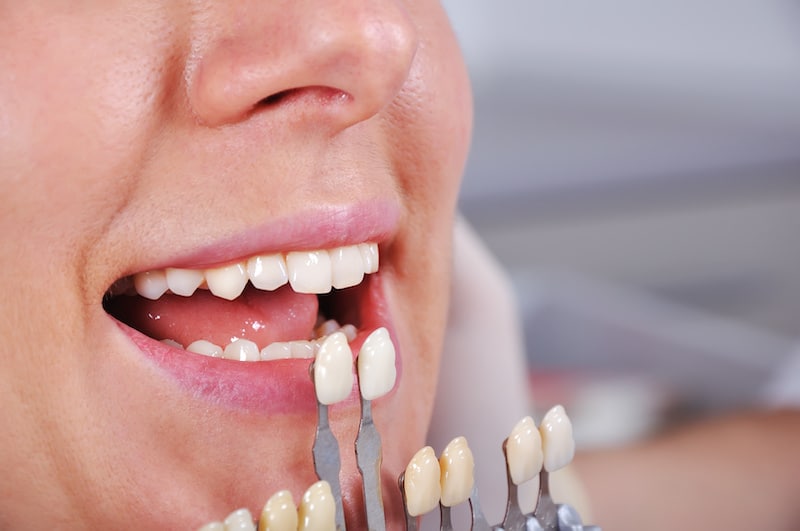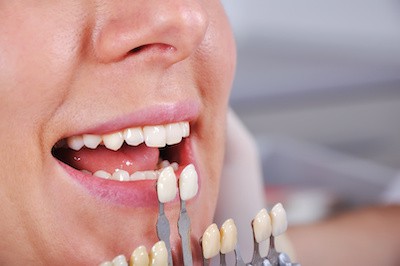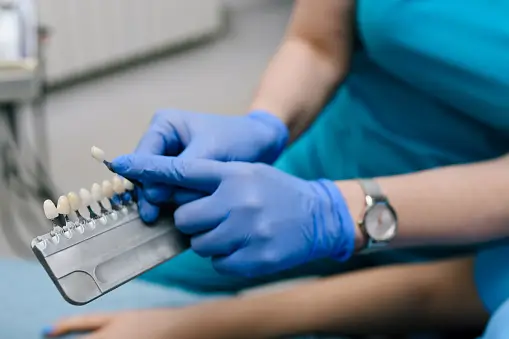
24 Feb Do Porcelain Veneers Need To Be Replaced?
What You Need to Know About Replacing Porcelain Veneers
I don’t know about you, but I’ve struggled with whitening my teeth for years and wanted to know if there was another way to achieve the same look. After going to the dentist recently, I asked about veneers and what all is involved with getting them. So, I did some research in case you were wondering the same thing!
Do porcelain veneers need to be replaced? Yes! It is important to treat veneers just like you would your teeth. Veneers experience the same wear and tear over the years as your teeth do and protecting and caring for them should be a priority. Thanks to advances in dental veneers, the average lifespan of a veneer is about 10 years but can be lengthened to 15 or 20 years with proper treatment.
In this post, we will cover everything you need to know about this cosmetic dentistry procedure.
What Are Porcelain Veneers?
If you’re like me, you may not know what a dental veneer is. Basically, a porcelain veneer is a piece of porcelain that is bonded onto the surface of your tooth’s original enamel. It is contoured to the shape of your tooth so that it is covered fully. A full set of veneers usually only includes about 8 teeth – typically your top, front teeth. However, many people also get veneers for their bottom teeth, or they only have one or two to cover chipped, stained, or broken teeth.
Why Do Porcelain Veneers Need to be Replaced?
Because veneers behave similarly to our normal teeth, they experience cracks and breaks too. As they begin to wear out, you might start to notice some discomfort or some visual changes – this is completely normal. Veneers are very durable when installed correctly, but they are not as strong and lasting as our teeth. Therefore, needing to replace veneers every 10-15 years is a normal process.
How to Know It’s Time to Replace Your Porcelain Veneers:
Now that you know what a veneer is and why they need to be replaced, here are a few examples of how you should know that it’s time to replace them.
 Veneers are chipped or cracked. Porcelain veneers are durable, however, they wear down over time and can experience cracks and chips just like our teeth. If you start to notice this – go get them checked out.
Veneers are chipped or cracked. Porcelain veneers are durable, however, they wear down over time and can experience cracks and chips just like our teeth. If you start to notice this – go get them checked out.- The wrong size veneers were installed. If your dentist didn’t measure your mouth correctly when installing your veneers, they can be uncomfortable and painful. Experiencing any discomfort that seems abnormal is a sign to go get them looked at.
- Veneers were installed improperly. Sometimes dental veneers can be installed improperly, even if they are the correct shape and size for your teeth. This can cause them to fall off – which is a hint that you should probably go get them fixed.
- Poor dental hygiene. Just like our normal teeth, we must maintain proper hygiene. This means that you should brush and floss and take care of your mouth just like you would your teeth – if not even more. Unfortunately, porcelain veneers can not be whitened. Without proper hygiene, they too will become dull and discolored.
- Tooth decay under the veneer. Even if your veneer is looking and feeling good, if the tooth underneath it is not – the veneer will need to be replaced. You will likely need to undergo some type of dental procedure to fix the decaying tooth before replacing the veneer.
Prolonging the Life of Your Porcelain Veneers
If you take care of your teeth and maintain proper dental hygiene, you will likely not have any problems. But just in case, here are a few reminders to keep your veneers looking like new for a lot longer.
- Brush and floss regularly. Brush your teeth at least twice a day, preferably after every meal. Floss at least twice a day, preferably after every meal.
- Avoid tobacco products. Tobacco products can cause staining, making your teeth and veneers appear yellow.
- Wear a mouthguard during contact sports. If you are involved in a sport or activity that could lead to contact near the head/face, you should wear a protective mouthguard or shield to prevent any chips or breaks.
- Visit your dentist twice a year for checkups. Maintaining regular visits to your dentist for dental exams and cleanings will help you catch anything that could turn into a problem later on and gives your dentist the chance to properly clean your teeth.
- Avoid food and drink that might stain your veneers/teeth. Coffee, soda, berries, tomatoes, and wine can stain your teeth over time. Eating/drinking in moderation is key to keeping your smile bright and white!
Reasons You May Need Porcelain Veneers
There are many different reasons for either wanting or needing a veneer, whether it’s a necessary or personal choice. Some of these reasons individuals opt for porcelain veneers include:
- Chipped or broken teeth
- Straighter smile without braces or other procedures
- Whitened smile
- Cosmetic preference
Deciding to get a set of veneers is different than deciding to get braces or any other dental alteration. The veneer process is less invasive and slightly more permanent. If you are looking to alter the appearance of your smile without having to wear braces, and veneers can cover any irregularities – they would be a great option.
There are also such things as temporary veneers. If you’ve been in an accident of some sort and chipped or broken a tooth, a veneer can be used to cover or hold its place until the tooth is fixed or until a permanent solution appears.
Related Questions

How much do porcelain veneers cost? Veneers, though they are the less invasive option for dental cosmetics, can still be pricey. Porcelain veneers are the more expensive option of veneer types and typically range from about $925-$2500 per tooth.
What is the procedure like? Porcelain veneers are a non-invasive procedure, getting or replacing veneers can take time but shouldn’t be painful or require any kind of anesthetic or drug. Your dentist will take the time to properly measure your mouth – oftentimes taking a mold of your teeth. This part could cause some mild discomfort, but no pain. After this is done, your dentist will send the measurements to a lab so that the veneers can be custom created.
If you’re covering up a chipped or broken tooth, a temporary veneer can be used until the permanent one is ready. Once the permanent veneers are ready, your dentist will remove the enamel off of your natural teeth – as the veneer will now be your “enamel”. Then, after your tooth is cleaned and air dried the adhesive will be put on, followed by the cement, and finally, the veneer will be bonded.
During the bonding process, the veneer will be light-cured to ensure that the veneer has fully attached to the tooth. After all of this is complete, your dentist will remove any excess material and you should be good to go!
How do I know if veneers are the right choice for me? Only you can ultimately decide to get veneers, but talking with your dentist is important. You’ll want to make sure that you fully understand the process, if you can afford it, and if any other options might be better suited for you. Call our Tulsa dentist team for more information on porcelain veneers or other cosmetic procedures!


Sorry, the comment form is closed at this time.